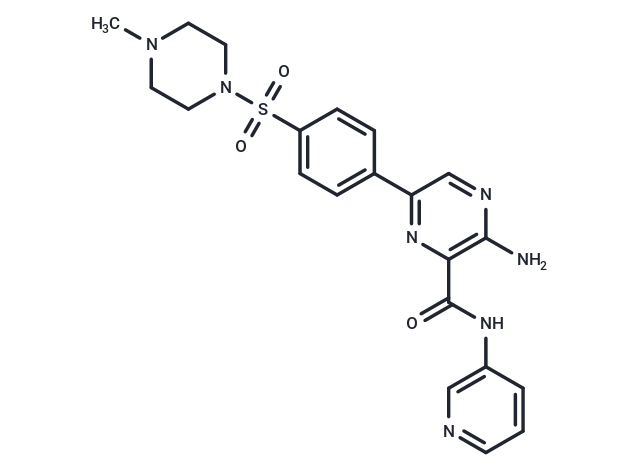Shopping Cart
- Remove All
 Your shopping cart is currently empty
Your shopping cart is currently empty

AZD2858 is a selective GSK-3 inhibitor, inhibiting tau phosphorylation at the S396 site and activating Wnt signaling pathway.

| Pack Size | Price | Availability | Quantity |
|---|---|---|---|
| 1 mg | $32 | In Stock | |
| 2 mg | $45 | In Stock | |
| 5 mg | $72 | In Stock | |
| 10 mg | $108 | In Stock | |
| 25 mg | $209 | In Stock | |
| 50 mg | $393 | In Stock | |
| 100 mg | $585 | In Stock | |
| 500 mg | $1,270 | In Stock | |
| 1 mL x 10 mM (in DMSO) | $110 | In Stock |
| Description | AZD2858 is a selective GSK-3 inhibitor, inhibiting tau phosphorylation at the S396 site and activating Wnt signaling pathway. |
| Targets&IC50 | GSK-3:68 nM |
| In vitro | After three weeks of treatment with 30 μM/kg AZD2858, rats exhibited increases in bone callus mineral density (28% at 2 weeks, 38% at 3 weeks) and mineral content (81% at two weeks, 93% at three weeks). Treatment with AZD2858 for 28 days resulted in time-dependent changes in serum markers of bone turnover, along with an increase in bone density. Within 7 days of AZD2858 treatment, the bone formation marker P1NP increased, and the resorption marker TRAcP-5b decreased, indicating enhanced bone metabolism and reduced absorption in rats. Oral administration of AZD2858 for two weeks led to a dose-dependent increase in bone density compared to the control group, with the greatest efficacy observed at a daily dose of 20 mg/kg (total BMC: 172% of the control group). AZD2858 treatment expedited bone fracture healing, with the presence of a bony callus and no significant cartilage components. |
| In vivo | AZD2858 induces β-catenin stabilization in human and rat mesenchymal stem cells, activating osteoblasts and osteogenic mineralization in vitro. Treatment with AZD2858 (1 μM, 12 hours) on primary isolated human osteoblast-like cells results in a three-fold increase in β-catenin levels. |
| Kinase Assay | Tau phosphorylation assay: NIH-3T3 cells expressing 4-repeat Tau are used to assess functional activity of AZD2858 in vitro. The cells are grown in DMEM media and 2 mM L-glut, and 10% HiFCS, and plated at a concentration of 6×105 cells/well in 6-well plates. In each experiment, AZD2858 is dosed in triplicates at a concentration of 1, 10, 100, 500, 1000, 2000 and 10,000 nM. Cells are treated for 4 h prior to cell lysis using 100 μL ice cold lysis buffer (0.5% NP-40, 10 mM Tris, pH 7.2, 150 mM NaCl, 2 mM EDTA). A suspension is made with addition of protease and phosphatase inhibitors: 50 mM NaF, 0.2 mM NaVO4 and Cocktail Protease inhibitors. The solution is then snap frozen at ? 80 °C for at least 1 h, before thawing on ice and lysate clarification by centrifugation, followed by Western blot according to standard protocols. After blocking, the blots are exposed to the primary antibody, Phospho-Ser396-tau (1:1000) over night, washed and incubated with the secondary antibody (donkey anti-rabbit, 1:5000), followed by a final wash. For re-probing, the primary antibody Tau5 (1:200) and the secondary horseradish peroxidase linked antibody (sheep anti-mouse, 1:10000) are used. All blots are developed using ECL Western blot detection reagents, Kodak X-ray films, quantified using densitometric analysis, and the ratio of S396 tau to total tau (tau5) is calculated. |
| Cell Research | Human adipose derived stem cells and rat MSCs (isolated from bone marrow of Sprague Dawley rats at less than 8 weeks after gestation) are cultured in a basal media of DMEM containing 5% FBS and 2 mM GlutaMax. Cells are seeded in basal media into 96-well plates (3–5000 cells/well) for 18 h before treatment with AZD2858 (0.3 nM to 20 mM). After 24 h, β-catenin stabilisation is measured.(Only for Reference) |
| Molecular Weight | 453.52 |
| Formula | C21H23N7O3S |
| Cas No. | 486424-20-8 |
| Smiles | C(NC=1C=CC=NC1)(=O)C=2N=C(C=NC2N)C3=CC=C(S(=O)(=O)N4CCN(C)CC4)C=C3 |
| Relative Density. | 1.408 g/cm3 (Predicted) |
| Storage | Powder: -20°C for 3 years | In solvent: -80°C for 1 year | Shipping with blue ice. | ||||||||||||||||||||
| Solubility Information | Ethanol: < 1 mg/mL (insoluble or slightly soluble) DMSO: 7 mg/mL (15.43 mM), Sonication is recommended. | ||||||||||||||||||||
Solution Preparation Table | |||||||||||||||||||||
DMSO
| |||||||||||||||||||||

Copyright © 2015-2025 TargetMol Chemicals Inc. All Rights Reserved.